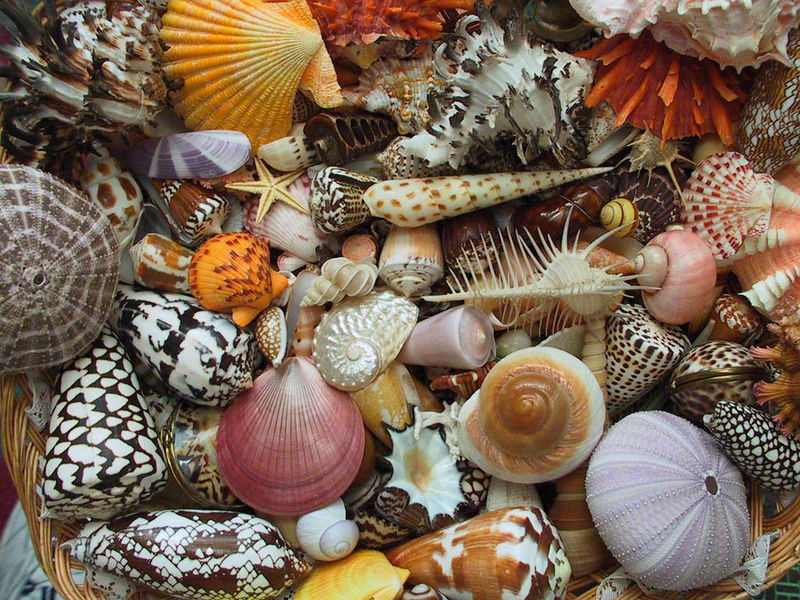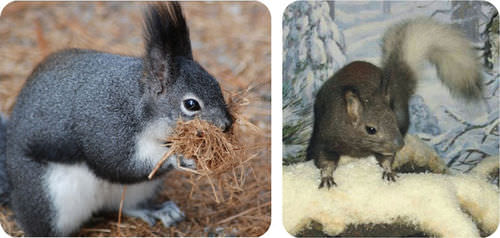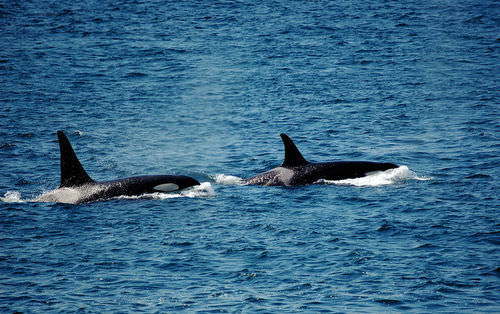4.9: Origin of Species
- Page ID
- 13366

Where did this diversity of life come from?
If you have ever been to the beach, then you realize there is not just one species of marine life. The wide variety of shells that wash up on the beach indicate that there are many forms of life in the ocean. This wide diversity of life requires that many new species have appeared over time. But how does a new species come into being?
The Origin of Species
The creation of a new species is called speciation. Most new species develop naturally. But humans have also artificially created new breeds and species for thousands of years.
New species develop naturally through the process of natural selection. Due to natural selection, organisms with traits that better enable them to adapt to their environment will tend to survive and reproduce in greater numbers. Natural selection causes beneficial heritable traits to become more common in a population and unfavorable heritable traits to become less common. For example, a giraffe’s neck is beneficial because it allows the giraffe to reach leaves high in trees. Natural selection caused this beneficial trait to become more common than short necks.
As new changes in the DNA sequence are constantly being generated in a population's gene pool (changing the population's allele frequencies), some of these changes will be beneficial and result in traits that allow adaptation and survival. Natural selection causes evolution of a species as these beneficial traits become more common within a population. Evolution can occur within a species without completely resulting in a new species. Therefore, evolution and speciation are not the same.
Artificial Selection
Artificial selection occurs when humans select which plants or animals to breed in order to pass on specific traits to the next generation. For example, a farmer may choose to breed only cows that produce the best milk. Farmers would also avoid breeding cows that produce less milk. In this way, selective breeding of the cows would increase milk quality and quantity.
Humans have also artificially bred dogs to create new breeds (Figure below).

Reproductive Isolation
There are two main ways that speciation happens naturally. Both processes create new species by reproductively isolating populations of the same species from each other. Organisms can be geographically isolated or isolated by a behavior. Either way, they will no longer be able to mate. Over a long period of time, usually thousands of years, each of the isolated populations evolves in a different direction, forming distinct species.
How do you think scientists test whether two populations are separate species? They bring species from two populations back together again. If the two populations do not mate and produce fertile offspring, they are separate species.
Geographic Isolation
Allopatric speciation occurs when groups from the same species are geographically isolated for long periods. Imagine all the ways that plants or animals could be isolated from each other:
- Emergence of a mountain range.
- Formation of a canyon.
- New rivers or streams.
Here are two examples of allopatric speciation:
- Darwin observed thirteen distinct finch species on the Galápagos Islands that had evolved from the same ancestor. Different finch populations lived on separate islands with different environments. They evolved to best adapt to those particular environments. Later, scientists were able to determine which finches had evolved into distinct species by bringing members of each population together. The birds that could not mate were a separate species.
- When the Grand Canyon in Arizona formed, two populations of one squirrel species were separated by the giant canyon. After thousands of years of isolation from each other, the squirrel populations on the northern wall of the canyon looked and behaved differently from those on the southern wall (Figure below). North rim squirrels have white tails and black bellies. Squirrels on the south rim have white bellies and dark tails. They cannot mate with each other, so they are different species.

Isolation without Physical Separation
Sympatric speciation occurs when groups from the same species stop mating because of something other than physical or geographic separation. The behavior of two groups that live in the same region is an example of such separation. The separation may be caused by different mating seasons, for example. Sympatric speciation is more difficult to identify.
Here are two examples of sympatric speciation:
- Some scientists suspect that two groups of orcas (killer whales) live in the same part of the Pacific Ocean part of the year but do not mate. The two groups hunt different prey species, eat different foods, sing different songs, and have different social interactions (Figure below).
- Two groups of Galápagos Island finch species lived in the same space, but each had his or her own distinct mating signals. Members of each group selected mates according to different beak structures and bird calls. The behavioral differences kept the groups separated until they formed different species.

Summary
- Speciation, the creation of a new species, can happen through natural selection or artificial selection.
- Reproductive isolation is necessary for speciation to occur, and this can happen through a geographic barrier (allopatric speciation) or without a geographic barrier (sympatric speciation).
- Different behaviors can result in sympatric speciation.
Explore More
Use the resources below to answer the questions that follow.
Explore More I
- Allopatric Speciation at http://www.pbs.org/wgbh/evolution/library/05/2/l_052_03.html.
- What is allopatric speciation?
- Give two examples of events that can cause physical separation of members of a population?
- How did scientists determine if the shrimp were two different species?
Explore More II
- Richard Dawkins: Diatoms: The Evolution of a New Species at http://www.youtube.com/watch?v=EUozZo8nOpY (2:10)
- What is a diatom?
- Where is Stephanodiscus yellowstonensis found?
- What technique did scientists use to determine what diatoms occurred historically in the lake where Stephanodiscus yellowstonensis now occurs?
- What were the environmental conditions when Stephanodiscus niagarae lived in the lake?
- What has happened to the diatoms in the lake as the climate has changed over the last 14,000 years?
Review
- Compare and contrast natural selection and artificial selection.
- What is meant by reproductive isolation?
- Compare and contrast allopatric speciation and sympatric speciation.

